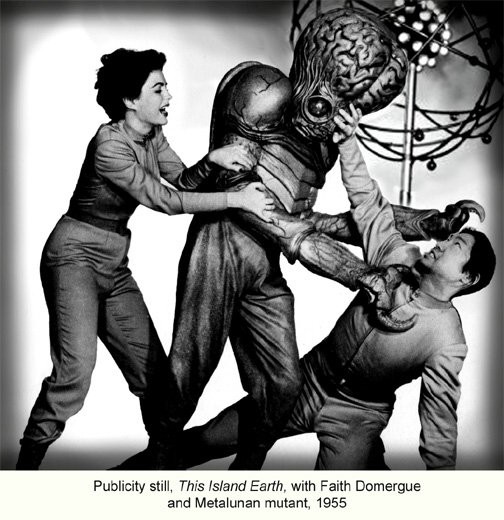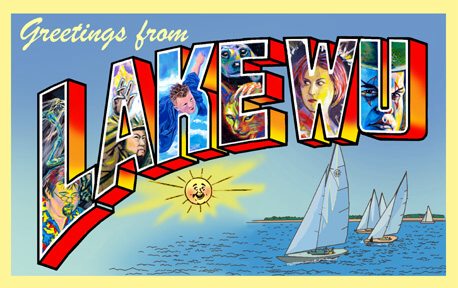

FOR THE BOOK "GREETINGS FROM LAKE WU"
WITH WORDS by JAY LAKE and IMAGES by FRANK WU
TO BE PUBLISHED BY WHEATLAND PRESS, FALL 2003
a hi-rez version of the cover illo is here.
ARTIST'S INTRODUCTION (rough draft, will need minor editing and fact-correcting by Jay)
When I was an undergrad at the University of Rochester, one of my English teachers was Professor Johnson. I don't remember much of anything he told us in a semester's worth of lectures, but I do remember that Mr. Johnson once said that writers were surprisingly dull conversationalists. You'd think they would be really interesting, what with all their stories about weird people and places. But no. He said writers were boring at parties.
At the time I didn't know any. But now a decade and a half have passed, and I am pleased to report that most of my closest friends are writers (like my pal Lori Ann White, who wrote that spiff-o-keen intro about me) - with a few artists sprinkled in for variety. And, actually, most of them I find really interesting. Perhaps Professor Johnson didn't know any science fiction and fantasy authors. Ahem.
And Professor Johnson certainly didn't know Jay Lake, or he wouldn't have made such a pronouncement. I met Jay Lake at the Norwescon science fiction convention in Seattle in early 2002. I remember standing there at a party with Derryl Murphy, editor of On Spec magazine, and we were having a contest of who'd been to the most interesting place or seen or heard the most interesting thing. Derryl told this story about retracing his grandfather's footsteps in the Northwest Territories. It was a really cool story involving getting lost in the snow, hypothermic hallucinations and a guy who shoots himself in the head and lives. For a while.
Derryl also told an interesting story about where he lives. It is a geographical oddity, like the one mentioned by George Clooney in O Brother Where Art Thou? Derryl lives in a place which is 8 hours from Edmonton (where he grew up and where his family lives); 8 hours from Peace River (ditto for his wife Jo); 8 hours from Calgary (which, surprisingly, is 2.5 hours south of Edmonton); 8 hours from Vancouver; a tad over 8 hours from Seattle; a tad under 8 hours from Prince Rupert; and a tad under 8 hours from Kelowna. Derryl adds: It's the middle of freakin' nowhere!
I told a story about the most beautiful thing I'd ever seen. I had just arrived in Australia and was taking a ferry across the Sydney harbor. I saw the Opera House, with its tan-colored sail-shapes gleaming, almost glowing in the sun against a flawless blue sky. Then a sailing ship slipped between me and the Opera House, and its sails, full of wind and sun, were the exact same shape and color as the Opera House. I stood on the deck amazed at this thing as big as a schoolhouse, gliding effortlessly past me without a sound, without a word. I was so stunned, and the beauty so fleeting that I didn't have time to take a picture, even though the camera was already in my hand. And the moment was gone.
Then it was Jay's turn. He told several killer stories, but there's one in particular that really struck me. But before I tell it, I should note for the record that Jay has an unfair advantage. You see, he was born in Taiwan and has lived in a bunch of places, like Nigeria and Bulgaria. That's just not fair. But the cool story he told was seeing the Tortoise Statue at Kharakhorum in Mongolia. Kharakhorum was Ghengis Khan's ancient capital, and long ago, three armies - one Chinese and two Mongolian - fought a terrible battle there. The entire city was leveled, and if you go there today you may find a few flat-topped rocks where were once there were buildings, or a couple steps that once led into houses. Much of the rubble that was higher than, say, your ankles was carted off to build a Buddhist temple which, in turn, was (almost) completely destroyed by the Communists. But there is one remnant, a statue of a tortoise that remains intact in the center of what was the Mongolian capital. This statue survived because it was sacred to all three of the rampaging armies. Everything was destroyed, but the tortoise survives, striding through the ages. How cool is that? In my book, Jay's story won the contest.
Jay's always fun to hang out with, Professor Johnson. He always seems to roll with the punches, always ready to play along. The last day of Norwescon, I was thinking about the sad state of the world. The attacks of September 11 had only occurred a few months before, and there were shootings in high schools in America or bombings on buses in Israel every day. There was no more good news, and everybody had a gun. I was thinking about the lines in Bob Dylan's song "Knockin' on Heaven's Door" about putting your guns in the ground and not shooting them anymore. So I wanted to do a painting, with rifles stuck in the ground, maybe with helmets on top, the way soldiers build make-shift monuments. I needed a model, and there was Jay, willing and ready to be volunteered. This meant finding a spot with strong and dramatic early morning light. Which meant the big windows by the hotel's registration desk, a high traffic area. And the illustration needed models lying on the ground in mock-agony and regret. Jay was totally willing to contorting himself in shame and disgrace for my camera. And he did it without embarrassment or self-consciousness, as more and more onlookers gathered. I thought that was pretty cool.
One last story I'd like to tell about Jay actually involves this book. Jay is a friendly guy, a big teddy bear. Very magnanimous. He insisted on the book not be considered a collection of his stories which happened to be illustrated by me. Rather, he thought of it as a collaboration: a bunch of his words and a collection of my art. (This relates to how one story in this collection - "Who Sing But Do Not Speak" - was inspired by a piece of artwork I had done.) I really appreciated that attitude - much different than the typical lack of respect artists get from editors and publishers.
This really came out during a lunch-time meeting I had with Jay, Wheatland Press publisher Deborah Layne, and our good friend and marvelous writer Nina Kiriki Hoffman. We were trying to decide on a name for the story collection. Jay noted that it seemed like every other story collection was called "'Name of One Famous Story" and Other Stories." He didn't want that. I thought it was interesting that a lot of story collections in the sci-fi field had the word "Strange" in the title. Stranger Things Happen by Kelly Link, Strange Monsters of the Recent Past by Howard Waldrop, Strangers and Beggars by James Van Pelt, Strange But Not a Stranger by James Patrick Kelly, or Strange Mistresses by James S. Dorr. Maybe, I suggested that something with the word "Strange" in the title might be appropriate. That idea didn't get very far.
Then Jay noted that two stories book-end the collection: "The Courtesy of the Guests" and "The Passing of the Guests." Perhaps something about Guests might make a good title, he said. I recalled to mind Jay's killer clown story "Trick of Disaster" and suggested that a good title for the book might be Guests and Other Disasters. That got a laugh.
Finally it was suggested that perhaps we could take advantage of the fact that Jay's last name was Lake, and within moments, we had the title Greetings from Lake Wu. The idea instantaneously followed that the cover would have a postcard like Bruce Springsteen's album "Greetings from Asbury Park." I was thrilled. Not just because it was a fun idea and would be interesting to work with. But mostly that... I got to be in the title! Me, the artist! No, the artist's name would not be left off the book - it still kills me that I have no idea who did most of that cool artwork for the James Blish Star Trek novelizations because the artists' names aren't given anywhere. And, no, my name would not appear only in tiny print, buried on the publication data page, or hidden in plain sight on the cover. No, I the artist would even get to be in the title! Hurrah! A triumph for all artists, in a way. How cool is that? And made possible only because of Jay's munificence.
I could go on telling cool Jay Lake stories - did I mention that if you go up to him and give him a word, any word, he can make up a funny story about that word for you on the spot? But I think I'll stop here. But wait. Before I go I should add that, in addition to being a good guy and a fun conversationalist, and a hoopy frood to hang with, he's a good writer. A darn good writer and fun to talk to, Professor Johnson.
ARTIST'S INTRODUCTION TO THE COURTESY OF GUESTS
This was a fun story to illustrate. The setting is a future earth, but the perspective is looking back on the ancient earth. It seemed appropriate to use as the visual gimmick a drawer in a museum. I have always been curious about the curios in the wooden drawers in the backrooms and basements of great museums. Only the tiniest fraction of their collections are on display. What treasures are hidden away, seen only by scholars and sleep-deprived grad students? Indeed, many recent "discoveries" have been made as scientists got around to cleaning fossils collected long ago. Almost makes me want to become a grad student in paleontology. Almost.
So the question becomes, what sorts of things would people in the far future find in the drawers of their museums? Characters and bits from this story, of course. So we find fragments of a sculpture of Ahrimen, playing his manbone quena. The two wooden figures represent Meschia and Meschiane, also from the story. These are the last people to return to earth, the Homo terminus. However, in a way, they are also an inversion of and commentary on Adam and Eve, as their names are the those of the Persian equivalent of the Biblical first couple.
In the illo two wooden figures - idealized visions of humanity as are Meschia and Meschiane - recreate the poses of Michelangelo's and Rodin's versions of Adam. Michelangelo's Adam (on the left in my piece) lies at rest, receiving the touch of God giving him Life. Rodin's Adam has eaten the forbidden fruit and is bent over in shame and disgrace, cast out of Eden and away from the Tree of Life. But the two are really the same pose rotated ninety degrees. All this theology conveyed by simply giving the figure a quarter turn.
So... What else could I put in my drawer? Images of the past can be used to evoke the future. In the film Things to Come, future scientists wear the togas of ancient Greece. In the future worlds of Gattaca and Brazil, people drive old French and German vehicles. So I have included in my divided drawer, inter alia, a faux antique cross, Roman coins with Constantine's face, Olmec artifacts, fossil ammonites and trilobites, a jumble of plastic ankylosaurs, and toy visions of futuristic airplanes. The past and the future jumbled together; they become indistinguishable on a large enough time scale.
[By the way, it should be clear by now that the illustrations in this book aren't designed to slavishly depict the scenes in the stories and only those scenes; Jay has been gracious enough to allow me the freedom to do artworks which are inspired by and/or comment on his stories. So I am actually breaking one of the cardinal rules of illustration, which is that the image's sole job is "to make you want to read the story." Sorry. But this was more fun.]
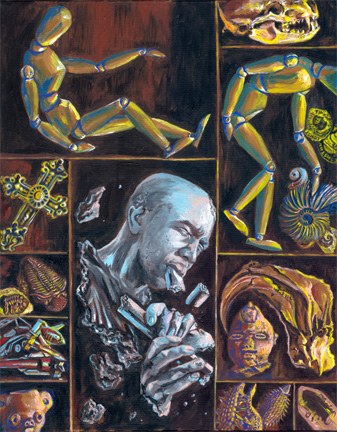
GLASS
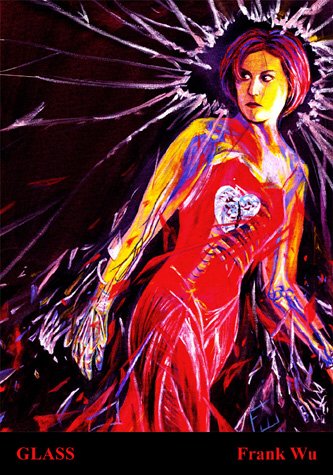
ARTIST'S INTRO TO "GLASS."
Because I have a busy schedule, several months transpired between when Jay and Deb and I started talking about this project and when I actually picked up a paintbrush to lay down the first blobs of paint. Much of that time was spent messing about [which, in translation, means tying up lose ends at work at our patent law firm and losing the big case I'd been working on for three years (oh well), before quitting to go into art full-time (yippee skippee)]. But in those months, I knew that when I finally started on this project, this illustration was the first one I wanted to do.
The first scene in Jay's story "Glass" is just tremendous. A woman is (at least partially) made of glass, but her glass heart is broken by her careless fiancee. She strides away from our hapless hero, indignant, very pissed off, shattering as she goes. A really cool image.
But for me, a piece of artwork is a point where many lines intersect. A depot where trains of thought meet. In addition to Jay's story, what came to mind was Marcel Duchamp's painting "Nude Descending a Staircase, number 2." In that Futurist painting, he shows multiple images of arms and legs, as if capturing the frames of an animated movie, all superimposed on each other. I wanted to do something like that here. But instead of having each picture of a swinging arm representing the same arm at different times, I wanted each picture to be a different layer as the arms disintegrated. Perhaps it is the anatomist in me; perhaps it comes from a vision burned into the conscious flesh of my young brain - a vision of Vincent Price (or was it Claude Rains?) as the invisible man, in an old movie, finally reappearing. First the bones materialize, then the muscles, then the veins and arteries, and finally the skin, as he lies very still and quiet to make the special effects artist's job easier. Then, fully restored, he turns to the camera and smiles to reassure the audience that he's all better now, thank you.
Only in Jay's story it's the reverse. The woman is definitely not smiling, definitely not all better now. Instead of flesh and bone coming together, it's all flying apart, like a C-Thru Visible Woman model with the plastic pieces going a-skitter-skatter. And it's all our hero's fault. And, because we the reader are meant to identify with the (male) protagonist, it is by extension our fault. My fault. Mea culpa. When he cut her, our hero was trying to give the girl a diamond engagement ring, but her forgot that diamond cuts glass. In a way, the image represents every woman with whom I've tried to do the right thing, but somehow managed to do it in a way that was wrong in her sight, thus hurting her or pissing her off unintentionally. If that's you out there and you're reading this, sorry about that. Yeah, I really am sorry. I really am. Look at the picture - see, I feel your pain...
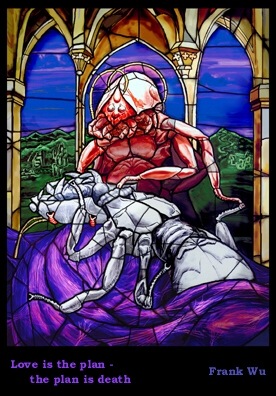
Artist's Comments on his piece "Love Is the Plan - The Plan Is Death" and Jay Lake's story "Who Sing But Do Not Speak"
I've always wanted to do a really large collaborative project with a bunch of other artists and writers. I've been doing lots of illustrations, based on other people's stories. But I thought it would be cool to have someone write a story based on my illustration based on someone else's story. And then take the second story and give it to a poet and have her write a poem based on that. And then someone else takes the poem and writes a play based on that. Then it goes to a different artist, who does another painting. Sort of like the game of "telephone," but with artists and writers.
Well, here in your hand is part of that vision fulfilled. I've always been amazed by James Tiptree, Jr.'s (penname of Alice Sheldon) story "Love is the Plan - The Plan is Death." Her stories often seem to revolve around death and sex, or both. And also life. In the story, the male insects give their lives as food, so their mates can survive the long winters. And my mind combined this with Michelangelo's La Pieta, which showed the Christ, who gave His life so that we might all have Eternal Life.
So when Jay and I were talking about the contents of the book you hold in your hand, I thought it would be fun to have not just art inspired by Jay's words, but also Jay's words inspired by my art. And I am totally pleased with his story "Who Sing But Do Not Speak". I think it's a marvelous extension of Tiptree's story and my art. Just amazing. I couldn't be happier.
[Addendum and Advert: I told Deb and Jay about the idea of the linked stories and art. This is an idea I borrowed from the Surrealists' game The Exquisite Corpse, based on an idea they originally got from an old parlor game. Deb agreed to publish the project, which I re-dubbed The Exquisite Corpuscle, for reasons that will become clear when Wheatland Press publishes this book sometime next year. Hurrah!]
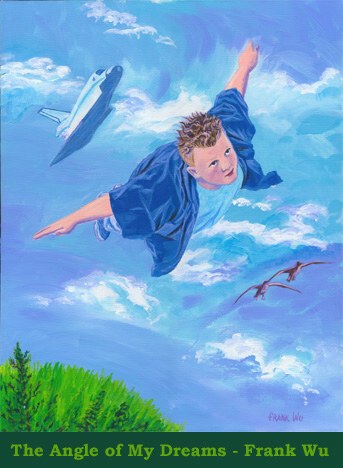
Artist's intro to "The Angle of My Dreams"
I loved this story. The idea of making wonderful things happen by the sheer power of enthusiasm. What could be more magical than flying, simply because you want to? To soar above the earth, to commune with clouds, birds and even the Space Shuttle. To make your arms transform into wings, and perhaps it's no accident that the boy's shirt takes on the shape of a butterfly... To pirouette and zoom so high that you can see the curvature of the earth, time and space bent to your will. Wow.
The story reminded me a lot of one of my all-time favorites: Ray Bradbury's "The Sound of Summer Running." That story is also about an enthusiastic little boy, who also stars in Dandelion Wine. The boy - Douglas Spaulding - is Ray's alter ego, as Douglas is Ray's middle name.
The model I chose for this illustration was a neighborhood kid who, I thought, looked like Jay might have when he was younger. He even has a name similar to Jay Lake's: Jake. And thus this boy, and this story, seem like a perfect representation of Jay's alter ego as a child.
ADDENDUM:
I did this painting and wrote this introduction about a month and a half before the space shuttle Columbia broke apart and burned up on re-entry on February 1, 2003. It has now been about twenty hours since my housemate woke me up to tell me the news. I consider myself a strong person, a go-getter, someone not daunted by large tasks. But as I write this my fingers are weak and my words and feelings faltering, uncertain. It's still a horrible shock to the system to recall to mind the footage of the shuttle breaking into chunks, smeared across the sky like butter across toast. That footage they showed over and over and over on CNN, like the World Trade Center collapsing in a ball of dust over and over and over again. Like being kicked in the head again and again; you couldn't make it stop, but you couldn't turn it off.
The shuttle broke up the way a meteor does, the way a meteor is supposed to. Horrifying to think of seven individuals falling from the sky 200,000 feet up, burnt beyond recognition. For four of the seven, it was a first space trip. How especially sad for the astronaut Ilan Ramon, the first Israeli in space. Maybe I was hoping that space could eventually be a place of reconciliation. In Star Trek we were taught that Russians and Americans could work together peacefully in space. Same was true later about humans and Klingons. In 1975, during a thaw in the Cold War, we saw some of that become reality when the Russian Soyuz capsule docked with the last American Apollo flight. Maybe in the future a space shuttle could carry aboard an Israeli and a Palestinian? Or maybe a descendent of Holocaust survivors and a descendant of Nazis?
It takes years to train an astronaut; with Ilan Ramon we were halfway toward my vision. He carried not only the hopes and aspirations of a small, war-torn country surrounded by enemies. But he also carried physical symbols, too, including a penciled moonscape drawn by a boy who later died at Auchswitz; Ilan's own mother had survived a year and a half there. He also carried a mezuzah; this is a small case holding text from Deuteronomy reminding us to love the Lord our God and serve Him and keep His commandments. A mezuzah is attached to the doorframe of a house and touched whenever you enter it. One Ilan carried had a Star of David ringed with barbed wire and was a gift from San Francisco artist Aimee Golant, whose grandparents survived the Holocaust. How sad. And, of course, it makes me terribly, terribly angry to see Iraqis gloating over this misfortune. They celebrate, calling it God's revenge, as Ilan had been one of the Israeli pilots responsible for blowing up Iraq's nuclear reactor two decades earlier and had fought in the Yom Kippur war before that. I shutter at the notion of this tragedy giving Saddam Hussein and his allies additional verbal ammunition on the eve of war. And how tragic for India, too. Her first astronaut, Kalpana Chawla who had flown on the shuttle before, also lost. How sad. And how sad for America, a country still weak with fear and quietly trembling after the horrible losses of September 11, 2001. This truly was a global disaster.
It is sad for me to look at my painting now that the Columbia is gone. Sad because the shuttle in the story and in the painting is the Challenger, but it might as well have been the Columbia. Sad because in the painting the shuttle is rising through the air, as is the little boy. Sad also because the boy will eventually tumble from the sky and return to earth. Sad because the Challenger had an explosion during ascent and then tumbled into the sea.
I did not personally know anyone who died aboard the Challenger, but I have friends who did. The Challenger's black astronaut, Ron McNair, had been the karate instructor for a friend of mine in Boston. And my friend Lisa Bartsch's family knew the family of the Challenger's Japanese-American astronaut, Ellison Onizuka. A month before the Columbia disaster, we had visited the Onizuka space center at the Kona airport on the big island of Hawaii. There on display were Onizuka's Boy Scout merit badges (he had been an Eagle Scout), and the first baseball he hit for a home run in high school.
And now I look again at my painting, and I see the space shuttle rising. And I remember that the fatal damage to the shuttle's left wing probably occurred early in lift-off, when a briefcase-sized piece of foam struck the wing's leading edge. The damage did not prevent the shuttle from reaching orbit and the missions itself was textbook perfect. Only upon re-entry was the extent of the damage self-evident. This was when temperature sensors and a tire pressure gauge went off the scale and failed, and then shuttle suffered what we euphemistically call "catastrophic failure," but which probably means either a hole starts at or spreads from a two-foot-long crack in the leading edge and then burns through the soft aluminum skeleton underneath, resulting in loss of big chunks of the wing, and the entire ship, which under the best conditions flies like a brick, loses control and tumbles, which would expose the top portion of the shuttle (which doesn't have any heat shields) to the searing heat of re-entry, probably concomitant with loss of power and computer control, and possibly the explosion of the hydrazine fuel tanks, followed by the 122-foot long shuttle being broken mostly into pieces no bigger than two or three feet across that are then strewn across the fields of Texas, Louisiana and several other states. But in my painting the shuttle is still rising. And I think of George W. Bush's words as he said, "The crew of the shuttle Columbia did not return safely to earth, but we can pray that all are safely home." Perhaps in my painting the shuttle is still rising, past the birds, past the clouds, past the attenuated tops of the atmosphere, all the way to heaven. Perhaps.
MURASAKI DOCTRINE
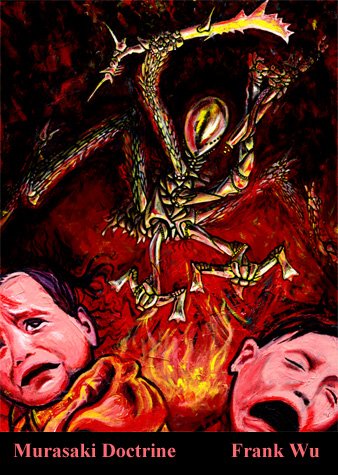
ARTIST's INTRODUCTION TO "MURASAKI DOCTRINE"
This piece didn't start out as a political statement, just a fun piece with a scary killer bug.
Then I added the two screaming kid faces at the bottom. The one on the right is from the famous Viet Nam picture of Kim Phuc, the girl who torn off her burning clothes and ran naked down the road during a napalm attack. This isn't Kim but another kid from the same photo. On the left is a refugee girl fleeing Basra during the war to topple Saddam (the second one).
It's a strange, disorienting thing doing art in a time of war. Though this piece is more about the suffering of children during War, not about the politics or justification (if any) of any particular war.
I don't want to bore you with my thoughts about the Iraq war, but I do want to talk about the happy ending to the story of Kim Phuc. Kim, burned so badly as a nine-year-old child, has had seventeen operations and enduring scars. But she has survived the war, with not just her body but her soul more or less intact. She has become a Christian and now teaches about forgiveness and reconciliation. She expresses no bitterness about her experiences, and is a good will ambassador the United Nations; she's even set up a foundation to help other children who have suffered in war.
Which only goes to prove that even in the most horrific of circumstances, some hope can survive.
G.O.D.
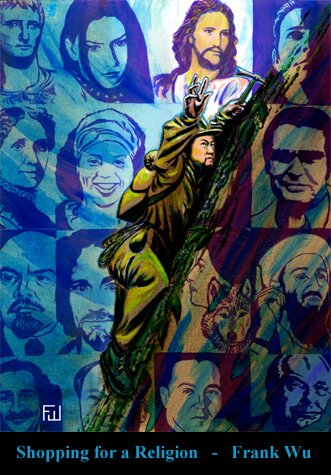
ARTIST'S INTRODUCTION TO ILLUSTRATION FOR "G.O.D."
Many of the illustrations in this book are simply my visions of specific scenes from the stories. "The Angle of My Dreams" and "Glass", f'rinstance, fall into this category. These illos were pretty-straightforward, as Jay uses a lot of cool descriptions in his work.
Sometimes, though, it falls on an illustrator to do a piece which is more symbolic and personal. This illo is all about a spiritual quest, a search for God, but not in a pathetic Star Trek V sort of way. To further pommel the idea that this book is a collaboration between Jay and me, we thought it would be fun to have us both appear in the illustrations themselves. Jay is the bartender in "Tall Spirits, Blocking the Night." And I am the climber in this illustration. Jay was actually really cool about this, because the character I play is actually Hungarian, and I'm Chinese. And if the author says it's ok for a Chinese guy to have a name like Janos, then it's ok. In the illo I'm ascending a beanstalk, attached to which are various Gods. I have been sent by my village to pick a good one.
I liked being in this particular image, because this part of the story is really about a spiritual quest. One of the most important decisions a person can make in a lifetime is what religion he/she will be. This is a decision that splits parents from their children, wives from their husbands. A monumentally, life-changing decision that re-defines you to the core. Each of us, one by one, need to climb that beanstalk and pick ourselves a god. And hence the illustration is really symbolically about the fall of 1982.
[At this point, as a disclaimer, I should say that I'm a Christian, but it's ok with me if you're not. I'm not here to convert anyone or yell at anybody, just here to tell you where I'm coming from. I said something very similar to this at a slide show at a convention and four or five people got up right then and there and walked out. I lost a couple fans, but I'm at a point in my life where I just have to say what I believe, popular or not. That said, if you don't wanna read any more of this intro, feel free to skip it and move on to Jay's nifty story. And Jay, by the way, represents a different worldview than mine. In addition to being a really cool guy, he is in his words "raving secular humanist." But we can still be friends.]
As I was saying, in the fall of 1982, after many years of soul-searching, I had decided that there was a God. I came to that conclusion after the summer of 1977. That was the summer my sister drowned. She was fifteen at the time, and I was twelve. It was, of course, the most wrenching, horrific experience of my life. In response to that horror, I withdrew, and I did a ton of drawing and writing. And some people thought it was pretty good. And I figured that if something this good could come out of something that bad, there must be a God. I'm not sure that's good theology, but it did lead me on a search for God. One of my next stops was the World Almanac. I figured that, in all these years, somebody must have found out who God was by now. So I went religion shopping, and the Almanac had a handy chart that compared the major religions of the world. I chose Christianity because it was the only one that really made sense to me. Yes, it does seem like sin separates people from God and from each other. It made sense to me for Christ to be the bridge that reunites us and God. Yes, love God and love your neighbor. That seemed to make sense.
There's a question more interesting than Why did you become a Christian? That's the question: Why did you stay a Christian? The reason is that there have been so many desperate hopeless times in my life where God stepped in. When I was in grad school, my mom died. Quite suddenly. One day months later, I was an emotion wreck. I was in lab and everything was going wrong. My test tubes shattered in the centrifuge and everything was going wrong. I ran away from lab and went to the local church on campus and just sat in the pew and cried and cried. It was a freezing cold day, and the church was huge and ornate but completely empty. I had been there twenty minutes and not a single other person had been there. And as I sat there crying, I really felt God's arms wrapping around me comforting me. Then this amazing thing happened. I had a voice in my head that said, Get up right now, go to the front of the church and someone you know is going to come in. It wasn't the Voice of Charlton Heston or anything, just words forming in my head. And my first thought was, No way. But the voice repeated the message. So I wiped my eyes, got up, went to the front of the church and right then a friend of mine from InterVarsity Christian Fellowship was walking in, a guy named Chris Franzen. I said, "Chris, what are you doing here?" He said, "I don't know, I just thought I was supposed to stop by." God had comforted me, then sent someone human to help out, too. Chris was suffering from a really bad rash that just wouldn't go away, and we prayed together and both felt immensely better after that. It was exhilarating in a way, going from deep despair to the highest joy as I saw God send someone to help in my darkest hour. And that for me is what the Christian walk is about.
So the illustration is about choosing Christianity from among other religions. Some of the alternatives are fairly reasonable, others I believe less so. Buddha is hidden under my chest. Cultists abound. L. Ron Hubbard is in the lower right. Jim Jones (2d row, 4th face) - for those who also don't know that Paul McCartney was in a band before Wings - was a cult leader who in 1978 thought it would be a good idea to assassinate a U.S. congressman, and then have over 900 of his followers drink lethal doses of grape juice mixed with cyanide and sedatives. John Edward (4th row, 3rd face) and Miss Cleo (2d row, 2d face) are more recent scam artists. The goth girl (1d row, 2d face) is included because sometimes a lifestyle can be almost a religion. Indeed, are we striving to be gother than thou? William Shatner (1d row, 4th face) is included because some of us are like unto Gods unto ourselves.
So we have choices of whom we will serve. I am not here to diss anybody's decision. As Tom Petty sang, You believe what you wanna believe. Just needed to tell you about my choice. Thanks for listening.
EGLANTINE'S TIME
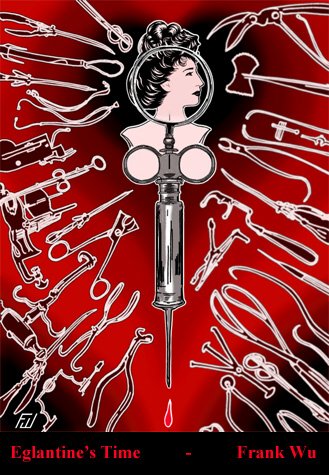
ARTIST'S INTRODUCTION TO EGLANTINE'S TIME
An illustrator's job is to read a story, figure out what it's about, and then convey that idea visually to the reader. This is what I discovered this story: it's about scary doctors.
Hence the woman and the syringe. I also thought it would be fun to draw some antique medical devices, because they're more horrifying than modern ones. Though not mentioned in the story, they convey the dread that pervades the tale. Hence the tools that wrench teeth from mouths, slice vertebrae from corpses, cut holes in skulls, rip skin to let blood, yank babies from wombs, guillotine tonsils, and snip out hemorrhoids. All the devices shown here are real, though some magnified to make them scarier.
And that's what - in my mind - the story is all about.
Have a nice a day.
TRICK OF DISASTER
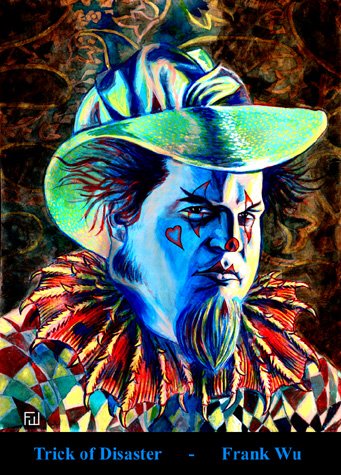
ARTIST'S INTRO TO TRICK OF DISASTER
I really do believe that every day is a gift from God, and every blank canvas is an opportunity for greatness.
Which leads me to wonder why I painted this... thing.
I read a sick joke once that an acceptable legal justification for homicide in some states is "Needed killin.'"
Well, maybe this image needin' drawin.'
JACK'S HOUSE
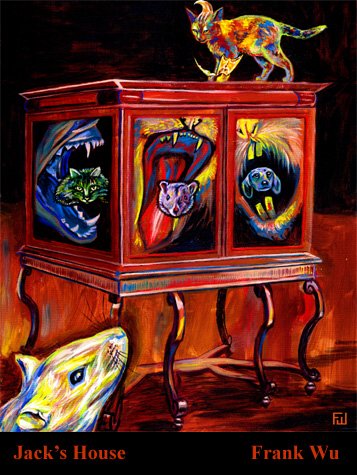
ARTIST'S INTRODUCTION TO "JACK'S HOUSE"
Writing an introduction to a piece of artwork is a weird thing, because you are describing a visual thing with words, and words (discounting the art form of typography) are not images but ideas. Laurie Anderson, quoting Steve Martin, said that writing about music was like dancing about architecture. It's like that.
For this introduction, I was even thinking about lifting a phrase from Harlan Ellison. For one story in his collection Shatterday, Ellison wrote a beautifully succinct one-sentence introduction: "I have nothing to say about this story."
I felt that way the first time I thought this painting was done.
Then I thought about what John Lennon once said. He had been asked what he thought of when he re-heard an old Beatles tune he'd recorded years ago. He said he remembered the circumstances in which it was recorded, the people.
So... when I think of this painting, a seemingly unrelated little phrase comes into my mind: "My name, Jose Jimenez." Seemingly unrelated. The story and painting are about rats, cats and dogs fighting with each other. And Jose Jimenez has nothing to do with that. For those who don't know, Jose Jimenez, a character created by comedian Bill Dana, had various adventures in the early sixties, most famously as a reluctant astronaut. Example: Ed Sullivan to Jose: Is that a crash helmet? Jose: I hope not. Example 2: Jose: The most important thing in rocket travel is the blast-off. I always take a blast before I take off. Otherwise I wouldn't go near that thing.
I think of Jose Jimenez as I look at this painting, because he appeared in The Right Stuff, which I was watching as I painted this and the other last paintings for this book, "Tall Spirits" and "The Goat Cutter." I needed to see this film then, because this was the week the Columbia died.
Jose Jimenez really struck a chord with me, because he made me laugh. When the Mercury astronauts went into space, we knew it was really dangerous. Our rockets regularly blew up in dramatic, horrific fireballs. Every safety precaution was taken, but there were really good odds that no matter what you did, no matter how good a pilot you were, the huge rocket under you could just explode without warning. (Don't worry, this really is connected to this painting, we'll get back to it, you'll see. Thanks.)
As I was saying... Only half a year before the first men went into space, as they say, something happened with a Soviet R16 at its secret launching pad in Kazakhstan. The rocket was fully loaded, but leaked fuel and had a balky new flight control system. Under intense pressure from the Kremlin to hurry up and launch, Marshall of Artillery Mitrofan Nedelin went to the launch pad for an inspection. He was violating all safety protocols, sitting in a chair meters from the rocket, barking orders at dozens of engineers, military staff of all ranks, political overseers and other civilians - all standing on the launch pad. Suddenly the second stage of the rocket ignited, exploding the fuel tank directly below. A fireball expanded out 120 meters in diameter; 90 people died, most instantly burned beyond recognition, some dying in hospitals later.
While no Americans have died in launch pad explosions, Americans were familiar with our rockets blowing up and our boys botching it, too. And there were other, unexpected dangers, too. Mercury astronaut Gus Grissom completed the second manned American flight, safely landing his spacecraft in the water. But the escape hatch prematurely blew, and Gus fell into the water and nearly drowned. A few years later, Gus and two other heroes died in a fire sitting on the launch pad atop Apollo I. They had less than a minute after detecting the fire. The astronauts, suffocating and burning up, struggled to open the command module's inner hatch, which was actually impossible because of the high air pressure inside the module. Technicians outside the module first ran for their lives, then returned with gas masks and fire extinguishers, fighting through dense poisonous smoke to find the tools needed to open up the ship. But within a minute, possibly within thirty seconds, it was already too late.
Jose Jimenez made fun of the fear and the danger. He made it all palatable.
In the decades since the Apollo I fire, there were no accidents, no deaths in the American space program except the horrific Challenger explosion. But that was in 1986, which now seems like a lifetime ago. And then there was the gallows humor, the tasteless Christa McAuliffe jokes, but somehow that made things feel better. How did Christa McAuliffe and her husband divide up the housechores? He fed the dog and she fed the fish. In all this time, we had forgotten how dangerous space travel was and is. Until now.
And so now the Columbia is gone, and we return to Jose Jimenez. Is that a crash helmet? I hope not.
(And now we reach the part wherein this Author assembles the various pieces he's thus far presented to the Patient Reader.)
After finishing this painting the first time, and thinking about this introduction and thinking about Jose Jimenez, I looked up the Harlan Ellison book to check the quotation. In Shatterday, Harlan wrote about how authors need to fearlessly stir people up, to force them confront their inner demons. In writing one story, he had come to the horrific realization that he wanted his mother gone. Not dead, not that, because that would be too terrible. But just gone. She had been deathly ill on and off for years, and hadn't been happy in ages. She was marking her days, and he was caring for her the way she had cared for him as a child. But he was drained and tired and exhausted, and sick of waiting for the inevitable to happen. And he just wanted it to be over, for her to be gone. And he felt ungrateful and scummy to make this realization, and hated himself for that. And when he said this on the radio, one woman whose mom had died of cancer said, Thank you for that, because I felt the same way and felt guilty, too, and I thought I was the only one. And now that it was out in the open, this horrible feeling could be dealt with.
And then, at that moment, I realized that the painting was not finished. Not done even though I had scanned it and shown it to Deb Layne, who dubbed it "Beautiful." Yeah, Beautiful maybe, but not done. And worst, it was dishonest.
The originally finished version of the painting still had the cat at the top and the mouse at the bottom, but they are as far apart as they could be and still be on the same canvas. The open jaws of the dog, cat and rat were there, but safely contained in little boxes. Everything tidy and safe, the personal demons in little cages. Maybe this was my way of dealing with the psychological distress of the Columbia disaster. Putting everything in boxes. This painting was my Jose Jimenez.
But upon reading Ellison's words, I realized that I had also snuffed out the horrific aspects of the story. This, like many of Jay's stories, has a nasty and unpleasant edge. Cats and dogs don't fight each other with ridiculous electronic gadgets; there is no comedic banter between them. Animals are ripped apart, flesh is torn asunder. Cute things die.
In order to finish the painting, I had to paint things inside the open jaws. It was then that I inserted the cute mouse - and he had to be cute - inside the cat's jaws. The cat - and he had to be cute - inside the dog jaws. The cute dog inside the rat's jaws.
Now it's done.
The world is a harsh place. There. Now I've said it. Perhaps there is a time for Jose Jimenez, and there is a time to mourn and grieve and lance the wound. No, the mouse is not safe, far from the cat. The jaws are not in neat little boxes. Danger is indeed everywhere, we just didn't want to see it before. Not just from terrorists, but from simply living on this planet. All living things die, some violently, some quietly as part of what Disney euphemistically called the Circle of Life. The world is a harsh place and children die, babies die, favorite grandmothers die, kittens and puppies die, even cute ones with floppy ears. Sometimes cute things are eaten by ugly things, sometimes thousands of people die in acts of senseless stupidity, and sometimes good people are blown up and burned beyond recognition 200,000 feet in the sky.
But you probably knew all that already. So let me go on and ask a question: How can a good God allow bad things to happen to good people? I do not ask this, because this question assumes that anything outside of what we personally would have planned is a Bad Thing, and it thus assumes that we should be God, and it assumes that there should be no death and no sickness and no pain and no stupidity and no jealousy and no irresponsible destruction in this world, which are all unrealistic hopes. So I do not ask this question.
Rather, I ask, Dear Lord, how to we respond when bad things happen? What can I do to heal the hurt?
The answer for that lies is another painting in this book. In my illo for "Tall Spirits, Blocking the Night," we first see a man in the lower left hand corner. A second man is slumped before him, wretched, aged, worn out from a lifetime of woe and care and self-pity. Meanwhile, harsh and powerful spirits trample them underfoot. But the first man is showing an act of kindness to the second; he is giving him a cup of coffee. And this is what I think God wants us to do in the face of tragedy and stupidity. Show kindness and love and giving to each other. We are here to overcome evil with good. We are here to give each other hope. Now more than ever.
End of sermon.
TALL SPIRITS, BLOCKING THE NIGHT
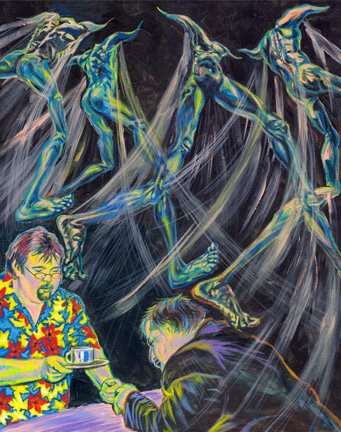
TALL SPIRITS, BLOCKING THE NIGHT
This was a fun piece to do. The model for the guy in the lower left is Jay Lake himself. He's wearing a Hawaiian shirt, because Jay always wears these at sci-fi conventions, which is the only time I see him. To see Jay not wearing one would be akin to seeing a cheetah with stripes or a zebra with polka dots. The other guy is Patrick Swenson, editor of Talebones magazine, who over the years has published a number of pieces by Jay and me, including this story (illustrated by someone else). The angle of Patrick's head is such that you can't really see him well, which is probably just as well, since I had to age him several decades to match the story. Sorry Patrick.
I thought I'd have some fun with the tall spirits that block the night, too. They are just described in the story as tall, but if an artist can't fool with the design of things which are meagerly described, well, why bother doing art? I thought it'd be fun if the spirits had sculpted bodies like Rodin's Walking Man and similarly didn't have heads, but wouldn't it be cool if they had tentacles instead of arms? Like human equivalents of Frank R. Paul's Martian war machines. With a jaunty step, like a Frank Kelly Freas sprite. Oh, and if they had extra knees. Oh, yeah, and if all their feet were right feet (did you notice that?). Also, they wear long coats, which are reduced to stringy gossamers that drag and cross each other, like a fine network of cobwebs. Definitely a lot of fun.
GOAT CUTTER
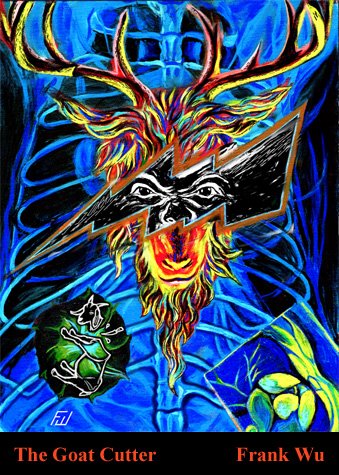
When an artist is given an assignment for a story, there are all sorts of directions to go.
One possibility is to emphasize the locale; Jay's intro comments on his Texan heritage. I've been to Texas; spent several weeks in El Paso visiting a friend, and then in Marfa, checking out the Donald Judd sculptures there. I also spent a wonderful, wonderful day across the border in Ciudad Juarez, where I experienced one of my greatest regrets in life. This was picking the wrong day to be practical, and deciding not purchasing an ammonite fossil from Chihuahua in a rock shop there. (But - tangent alert - if my largest regret in life is not buying a cool rock when given the chance, I suppose I'm doing OK - end of tangent).
But, no Texas doesn't loom large in my consciousness. So what to paint for this story? Frank Kelly Freas says that, should all else fail, you can almost always paint a pretty girl and that will fly. Problem is, for this story, there are no pretty girls, no, not really, unless I really wanted to stretch the story all out of shape.
One trick I have discovered, though, is that, lacking other inspirations, any image looks cool when inverted. They used that trick in the first episode of The Outer Limits, "The Galaxy Being," wherein the alien looks really cool and glowing because they used the film negative.
So I took the creature in Jay's story, with the head of a ram, the eyes of an angry baby, and the rack of a prize deer, and painted the negative of those. And why is there a lightning bolt across the face? Perhaps it is a riff on a David Bowie cover, or perhaps just, well, 'cos I felt like it, and does there have to be more explanation? And why is there a flower with a decapitated goat? Well, the goat is clear, but why a flower? Well, Georgia O'Keefe painted animal heads with flowers, so I thought, why can't I, too?
And since there's a lot of, well, anatomical discussions in the story, I thought I'd throw some of that stuff in, too.
There's a saying in the writing biz, "No tears in the writer, no tears in the reader." Well, the same is true about art, too. So I really needed to go into a head space where I was thinking a lot about anatomy, my own anatomy. Since there's much cutting of flesh in this story, I thought: Well, when was my own flesh cut? Well, there was that time a couple years ago when I was bringing the garbage down the stairs, and for the fun of it, I was banging the garbage bag against the side of my lower leg. Dang thing sliced me right open. After I was cut, I thought, well, not so bad and I walked down the two flights of stairs to the dumpster and then walked up before I got a friend to help me. I had never been cut deeply enough - before or since - that I could see my own muscle. Muscle is meat. The stringy stuff that's red in the white styrofoam and then turns gray and brown when you cook it. So weird to see all that red under my skin. It was all eventually ok. I taped up the gash - I literally used scotch tape to close to wound, after rinsing it thoroughly with hydrogen peroxide. I repeated this a couple times a day for the next week - carefully pulled off the transparent tape, rinsed, and stuck the tape back on to close up the wound. Never went to a doctor. It never got infected and today, years later, there's hardly any scar. So I thought maybe I could draw a big gash. But, no, that wasn't the really cool image I really wanted.
Then I remembered that I actually had had an MRI done of my own heart, back in 1993. I was in grad school at University of Wisconsin-Madison at the time, and I had a friend who was developing new MRI techniques. He asked if I'd like to be paid to lie really still in a claustrophic white-plastic tube for a couple hours. I said, sure, and he took some scans of my heart and that's what you see here. He said he could see my coronary arteries really really clearly, which is a good thing. Life is good.
The chest in the background is actually that of my friend Lisa Bartsch's dog Pearl. Pearl's tiny - a mix of Chihuahua and toy fox terrier and if you mate two little dogs you get a little dog. People would see Pearl and say, "Yo quiero Taco Bell." Pearl didn't get the reference.
I had taken Pearl in for a weird little growth on the back of her neck, but the vet said, aw, that's nothing, just a wart, but, hey look, did you know that little Pearl, cute little Pearl, has got a heart murmur? Didn't know that? Well, it's probably from a valve between her left atrium and left ventricle not closing all the way. This creates backwash and her heart has to work harder to pump blood into the rest of her body. So the day I did the bulk of the work on this painting, I took Pearl to get X-rayed and sure enough, her heart (unlike the Grinch's) was two sizes too big. Poor little dog. She seems happy and healthy enough, but this is just something that we'll have to worry about until it manifests itself as a big problem, which eventually it will.
So, there we are all together, Pearl's chest in the background, my heart in the lower right, and Jay's weird creature in the center. One happy family of weirdness.
SCENT OF ROTTING ROSES
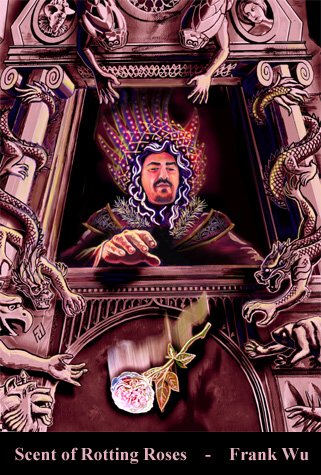
DRAFT OF SCENT OF ROTTING ROSES
ARTIST'S INTRODUCTION TO "SCENT OF ROTTING ROSES."
Some of these illos depict scenes from the stories; some are really "inspired" by the stories. This one is a little of both. Here we see the Vizier dropping a rose - a highly valued commodity in this story - from a high window. The rose falls onto the street and people walk around it, like it's a dead body. And that's pretty much all the description Jay gives. Which scant description, of course, is an excuse for the Artiste to go nuts with the illo.
I thought it would be fun if gargoyles grabbed at the rose as it fell from the window. (Yes, I know, technically they're grotesques because gargoyles have water pipes in their mouths and grotesques don't. But, well, don't get technical with me unless you want me to get technical with you back, ok?)
Some of the gargoyles have designs inspired by my love for paleontology and biology. The one in the lower right is a Hallucigenia from the Burgess Shale. A mysterious creature from the Cambrian explosion unlike any alive today. It has seven (!) pairs of spines and legs. This is the one that so perplexed early paleontologists that they drew it upside-down. Above it is a water bear, a weird creature about a millimeter long. It can be seen in marsh water under the microscope, slowly lumbering up a stalk of moss on eight stubby little legs. It's so weird it gets its own phylum (Tardigrada). The fish gargoyles around the rose window are Bothriolepis. This is a kind of placoderm (armored fish), and it was possibly the most common and successful fish in the late Devonian, the age of fish, 360 million years ago.
The gargoyles aren't in Jay's story. But because they're made of stone, they don't catch the rose. So neither do they change the plot. So, um, yeah, they could have been in the story, right? In the alternative version of this story in my parallel universe, the gargoyles are in the text.
THE PASSING OF THE GUESTS
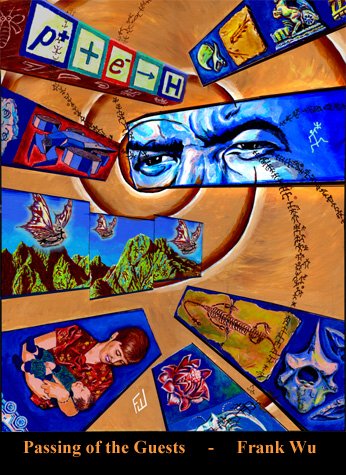
ARTIST'S INTRODUCTION TO PASSING OF THE GUESTS
This is the final piece for this book. Finishing such a big project brings a great relief, and a tremendous sense of accomplishment. But it also brings some sadness, and a tinge of regret.
All through high school I worked stage crew. I was set designer for 10 (count 'em!) plays. Born Yesterday. The Odd Couple. Stage Door. A couple Woody Allen plays. So many productions. My entire high school career, and perhaps the one redeeming thing about high school. I designed a device that would deliver a Greek God unto the stage (a Deux ex Machina, doncha know). I built a semi-circular window out of drywall, and another window, with a dozen square panes, out of masking tape painted white. I covered otherwise blank and boring walls with ten-foot tall stencils which celebrated and illustrated the animal kingdom, from the humblest tube worm to the crowning achievement, the mammalian brain.
But when it was over, four years and ten plays later, there was a pall of regret over the whole endeavor. Because there were things I had wanted to do that we never did. I never did a front or rear projection for an outdoor scene. I never cut up an aluminum pie tin and put it in front of a theatrical light to cast weird abstract shapes, perhaps tree-shapes or scary tilted triangles like The Cabinet of Dr. Caligari. I never built an octagonal window. Our neighbors the Byrnes down the street had an octagonal window in the front of their house. I always wanted one in one of my sets. But I never got one. Dang. And my theatrical years were over.
And so this project is wrapped up. So many things I love dearly are represented. I love fossils, so there's no fewer than four in this painting - a Chinese fish fossil, graphtolites (weird spiral spikey things), a Keichousaurus (Triassic lizard from China) and a Marrella from the magical Burgess Shale. Immediately to the left of the eyes is my design for a stealth VTOL aircraft. The ducts and tail pivot during launch. I designed and built a model of this while I was working on an illustration for Mark R. Hoover's story "Slugball", which had appeared in Strange Horizons two years ago. I did two illos for that story, but wound up not using the VTOL at all. Perhaps it was just an excuse to build a model. Anyway, it felt good to finally use it here.
So many cool little tchotchkes (cool at least to me) in this piece. A real tiger claw my old Chinese grandma gave me. A souvenir from Roma my friend Abra Sands brought back for me. Petroglyphs I saw pecked into Hawaiian lava. A cow vertebra I found in northern California while hunting (unsuccessfully) for brachiopod fossils. A shark tooth I bought at the best fossil store in America, Dave's Down to Earth Rock Shop in Evanston, Illinois. A couple modern arrowheads, including one I got at a Texan gas station ("Free Arrowhead With Every Tank of Gas").
So many cool things, and yet I had pages and pages of designs for this painting. I had so many ideas. The spiral represents the universe. I got this (with permission) from artist Hiroki Morinoue, whom I met on the big island of Hawaii. He showed me symbols for water, radiation, pollution and a bunch of other stuff I don't remember now, but all of which I wanted to incorporate into this piece. And then there were all these Hawaiian tiki gods, many of which represent the First Man (which fits the theme of the story), which I wanted to put into this piece, too. And a Polynesian sea chart made of reeds tied together. And I wanted to do a visual pun, with fan-shaped fossil crinoids and fan-shaped lava formations. (Can you tell I thought about this piece a lot in Hawaii?) And then I wanted to add the formulae my friend Jim Terman wrote out describing exactly how to use fusion to make helium. So much coolness.
And so it's sad to see a piece and this book finished, because there's always so much that could have been. Every canvas is an opportunity for coolness, but a single canvas can only hold so much. Some pieces need to be simple, like "The Angle of My Dreams," and others need to be complex and chock full of stuff, like this one.
Like Dylan, I got a head full of ideas and it's driving me insane. I guess I'll just have to go and get these down on canvas before my brain explodes.
Oh, yeah, almost forgot: hidden in each of the black and white images is the name YMIR, after Ray Harryhausen's creature.
OK, see ya later. Gotta go draw more shtuff now.
INSERTS:

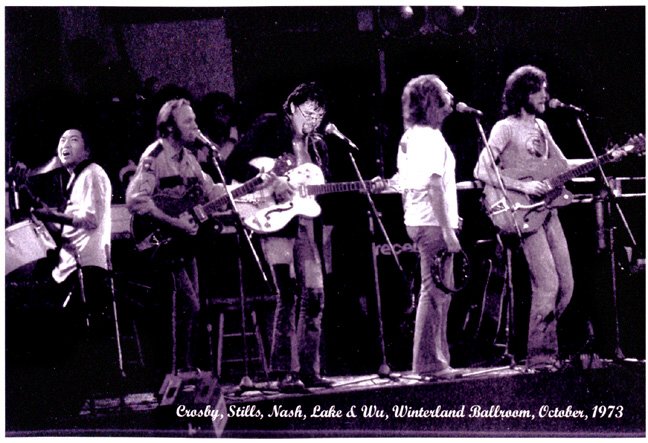
CROSBY, STILLS, NASH, LAKE & WU, Winterland Ballroom, San Francisco, 1973
This was done by a friend of Jay's. I call it "Being Jay Lake:"
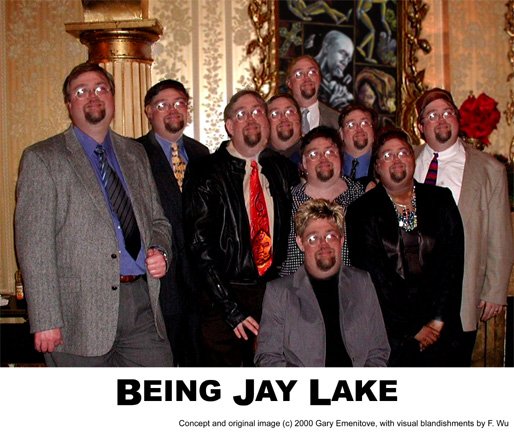
Publicity still, This Island Earth, with Faith Domergue and Metalunan mutant, 1955
